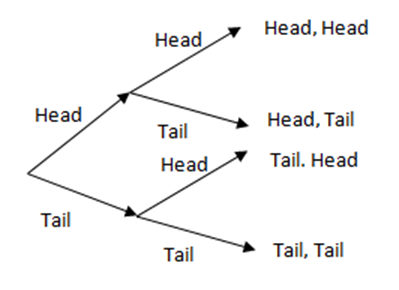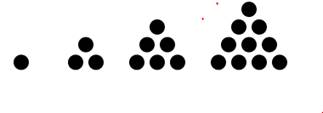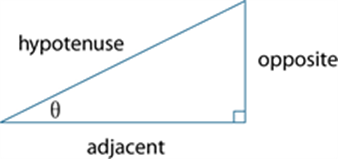Tree diagram
A diagram consisting of line segments (edges) connected to points (vertices) like the branches and twigs of a tree, a tree diagram is used to indicate the relationship between sets or events, for example a family tree.
Tree diagrams can also be used to represent the set of outcomes of a multi-step random experiment, for example, listing the possible outcomes when a coin is tossed twice as shown:

See also: edge, vertex.
Trial
A trial is any repeatable procedure with a well-defined set of possible outcomes, known as the sample space. An example of a trial would be the flipping of a coin; the sample space would be {H, T}. See also: probability, sample space.
Triangular number
A triangular number is an element of the set {1, 3, 6, 10, 15 …}. These numbers can be represented as dots that form a triangular array as shown:

See also: square numbers.
Trigonometry
Trigonometry is the study of measures related to triangles. Consider the following right-angled triangle, with hypotenuse ![]() , right angle, angle q and sides
, right angle, angle q and sides ![]() (opposite the angle q ) and
(opposite the angle q ) and ![]() (adjacent to the angle q ) as shown:
(adjacent to the angle q ) as shown:

The relation between the angle q and the lengths of the three sides are defined by the trigonometric ratios:
![]()
![]()
![]()
or equivalently:
![]()
![]()
![]()
Similarly, in the following right-angled triangle, with long side length 1 unit, and angle ![]() , the vertical side length is
, the vertical side length is ![]() and the horizontal side length is
and the horizontal side length is ![]() :
:
If the triangle is dilated by a factor ![]() from the point at which the angle
from the point at which the angle ![]() is formed, then, by similarity:
is formed, then, by similarity:
![]()
![]()
![]()
with altitude (height) ![]() , base
, base ![]() , and angle
, and angle ![]() as shown:
as shown:
See also: sine, cosine, tangent (trigonometry identity).
Two-dimensional
An object with width and length is two-dimensional. A polygon is an example of a two-dimensional geometric object. See also: three-dimensional.
Two-way table
See: Karnaugh map.
U
Undefined term
A term or expression taken as accepted without definition. These are the basic building blocks of mathematics. For example, element and set are undefined terms in algebra and logic, while point and line are undefined terms in geometry. Undefined terms may be characterised by informal description or illustrated by examples. Other mathematical terms and expressions are defined using undefined terms and relations on them.
Union (set)
Given two sets A and B, their union, written A ∪ B is the set of all elements which occur in either set, listed without repetition. For example, if A = { a , b , d , z } and B = { a , c , x , y , z } then A ∪ B = { a , b , c , d , x , y , z }. See also: set.
Unit
A unit is a basic or fundamental construct for counting and/or measurement. For example, the number 1 is the unit for counting (from the Latin unus for one). The metre is the standard unit for measurement of length in the metric system.
Unit fraction
A unit fraction is a simple fraction whose numerator is 1, that is, a fraction of the form ![]() , where
, where ![]() is a natural number. For example,
is a natural number. For example, ![]() is a unit fraction but
is a unit fraction but ![]() is not a unit fraction.
is not a unit fraction.
See also: fraction.
Univariate data
Data relating to measurement of a single variable, for example, shoe size. See also: data.
Universal set
The set containing all objects or elements, including itself, within a given context. The complement of the universal set is the empty set.
See also: complement (set), empty set, set.
Unplugged
A commonly used term for computational thinking activities carried out without digital technology. “Unplugged” representations of algorithms may include structured mathematical processes, English representations (steps) or flowcharts.
Source: https://victoriancurriculum.vcaa.vic.edu.au/LearningArea/LoadFile?learningArea=mathematics&subject=mathematics&name=Mathematics%20Glossary.docx&storage=Glossary
Web site to visit:ttps://victoriancurriculum.vcaa.vic.edu.au
Author of the text: indicated on the source document of the above text
If you are the author of the text above and you not agree to share your knowledge for teaching, research, scholarship (for fair use as indicated in the United States copyrigh low) please send us an e-mail and we will remove your text quickly. Fair use is a limitation and exception to the exclusive right granted by copyright law to the author of a creative work. In United States copyright law, fair use is a doctrine that permits limited use of copyrighted material without acquiring permission from the rights holders. Examples of fair use include commentary, search engines, criticism, news reporting, research, teaching, library archiving and scholarship. It provides for the legal, unlicensed citation or incorporation of copyrighted material in another author's work under a four-factor balancing test. (source: http://en.wikipedia.org/wiki/Fair_use)
The information of medicine and health contained in the site are of a general nature and purpose which is purely informative and for this reason may not replace in any case, the council of a doctor or a qualified entity legally to the profession.
The texts are the property of their respective authors and we thank them for giving us the opportunity to share for free to students, teachers and users of the Web their texts will used only for illustrative educational and scientific purposes only.
All the information in our site are given for nonprofit educational purposes